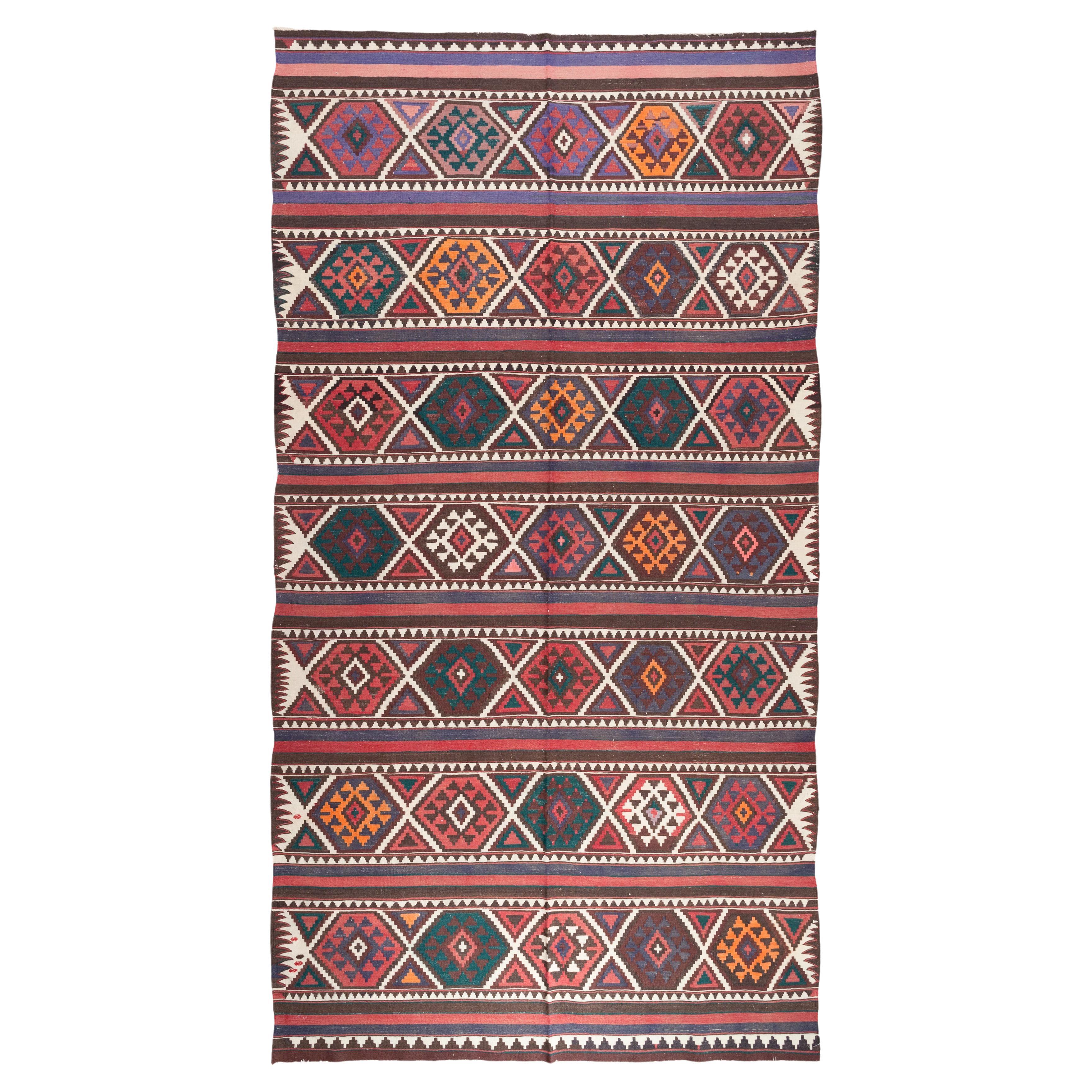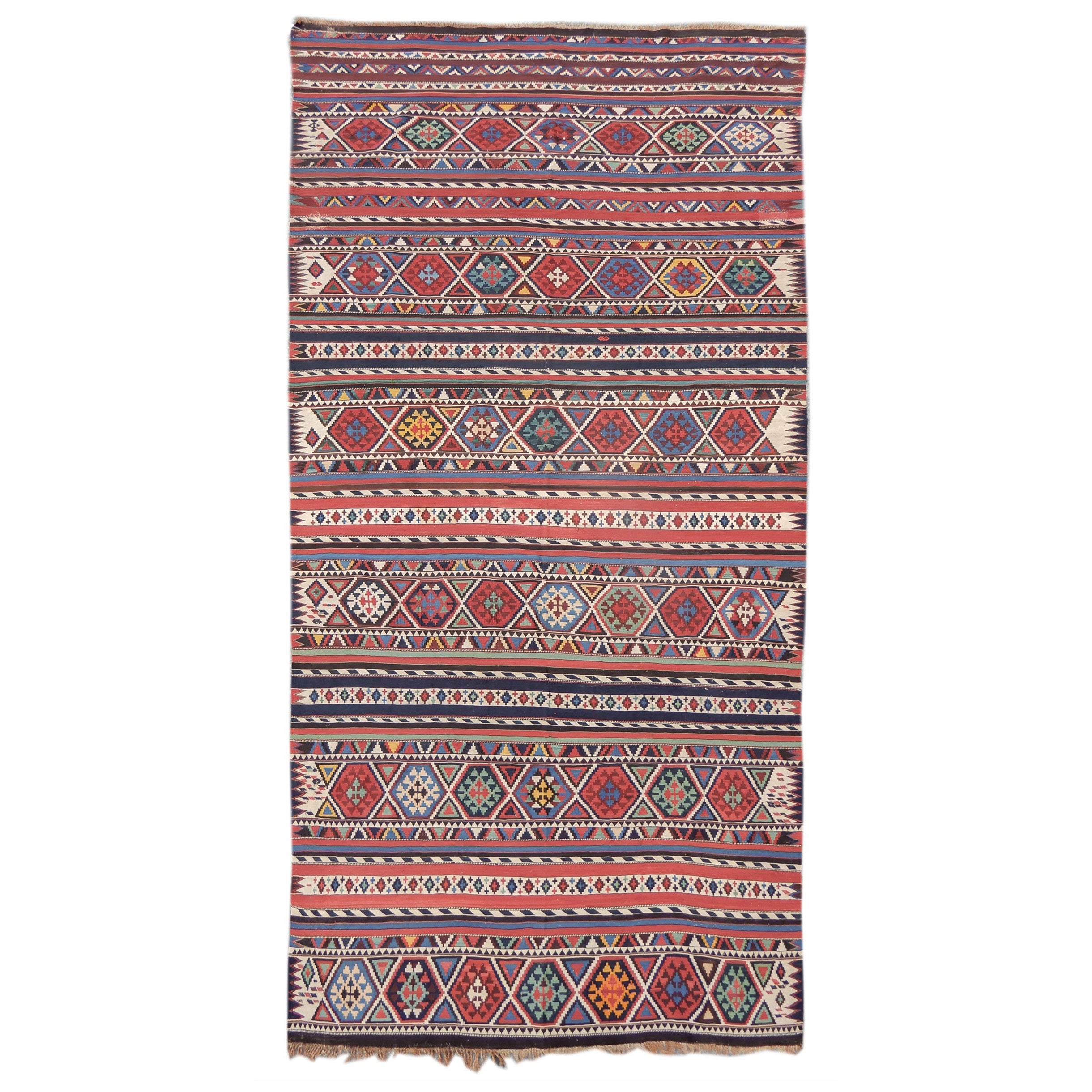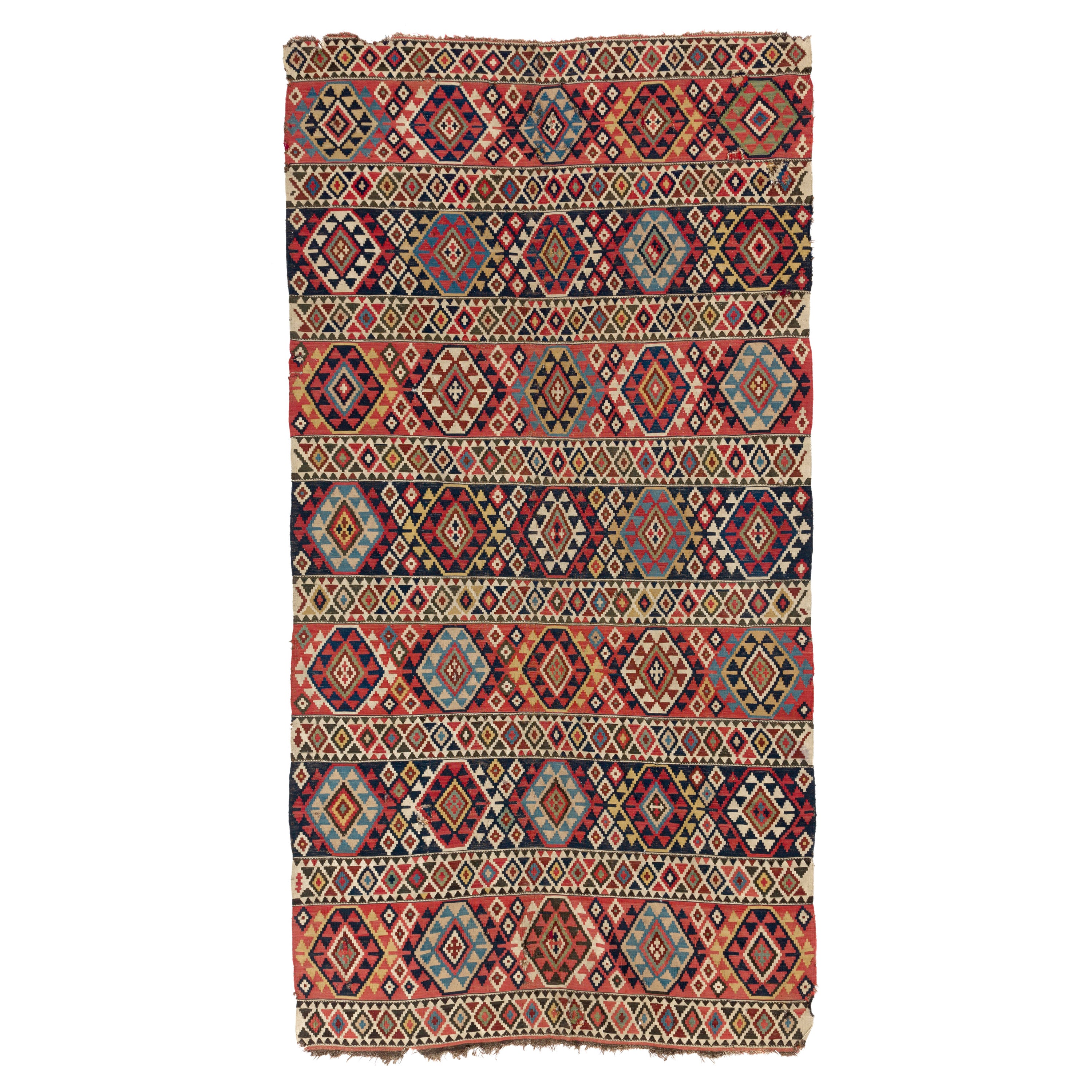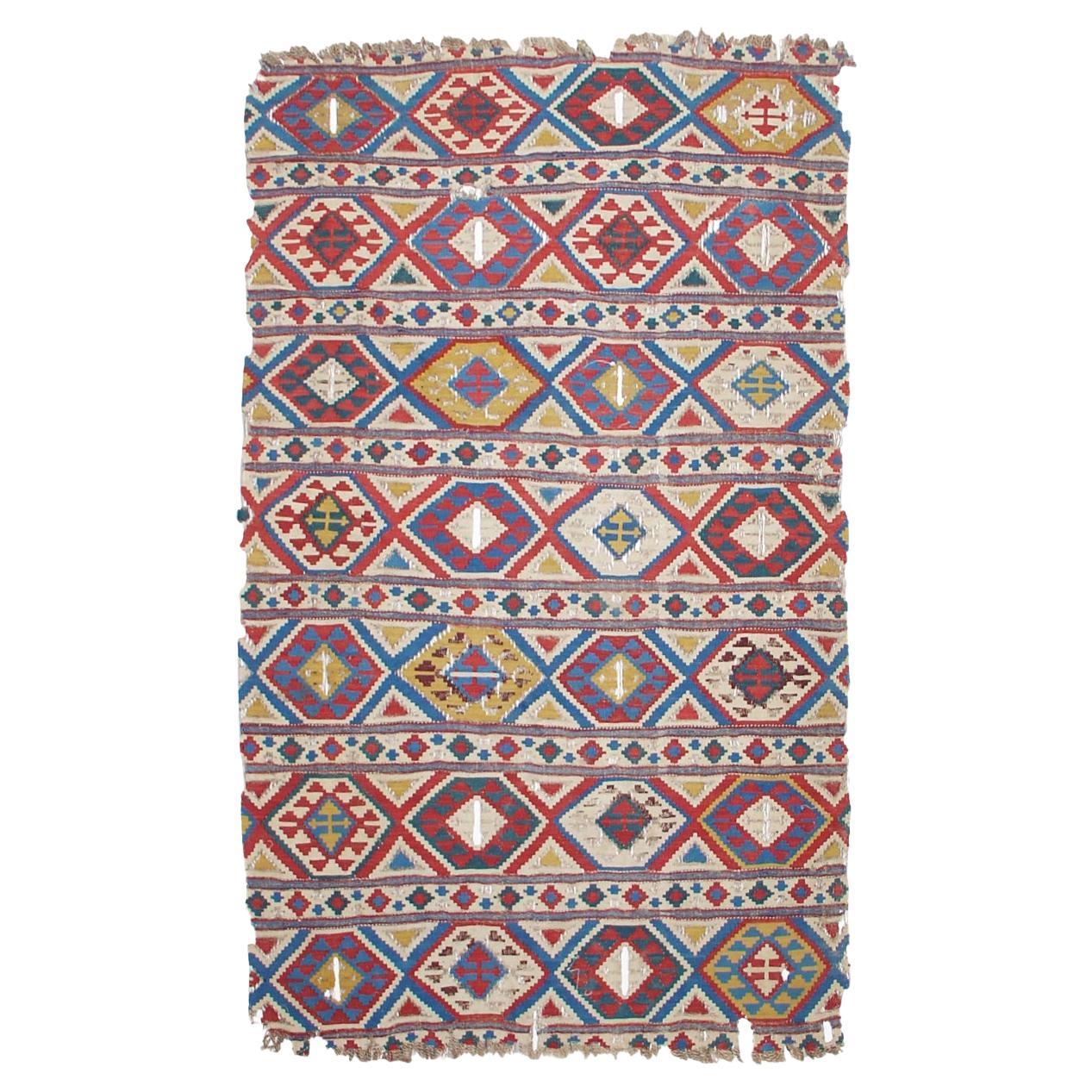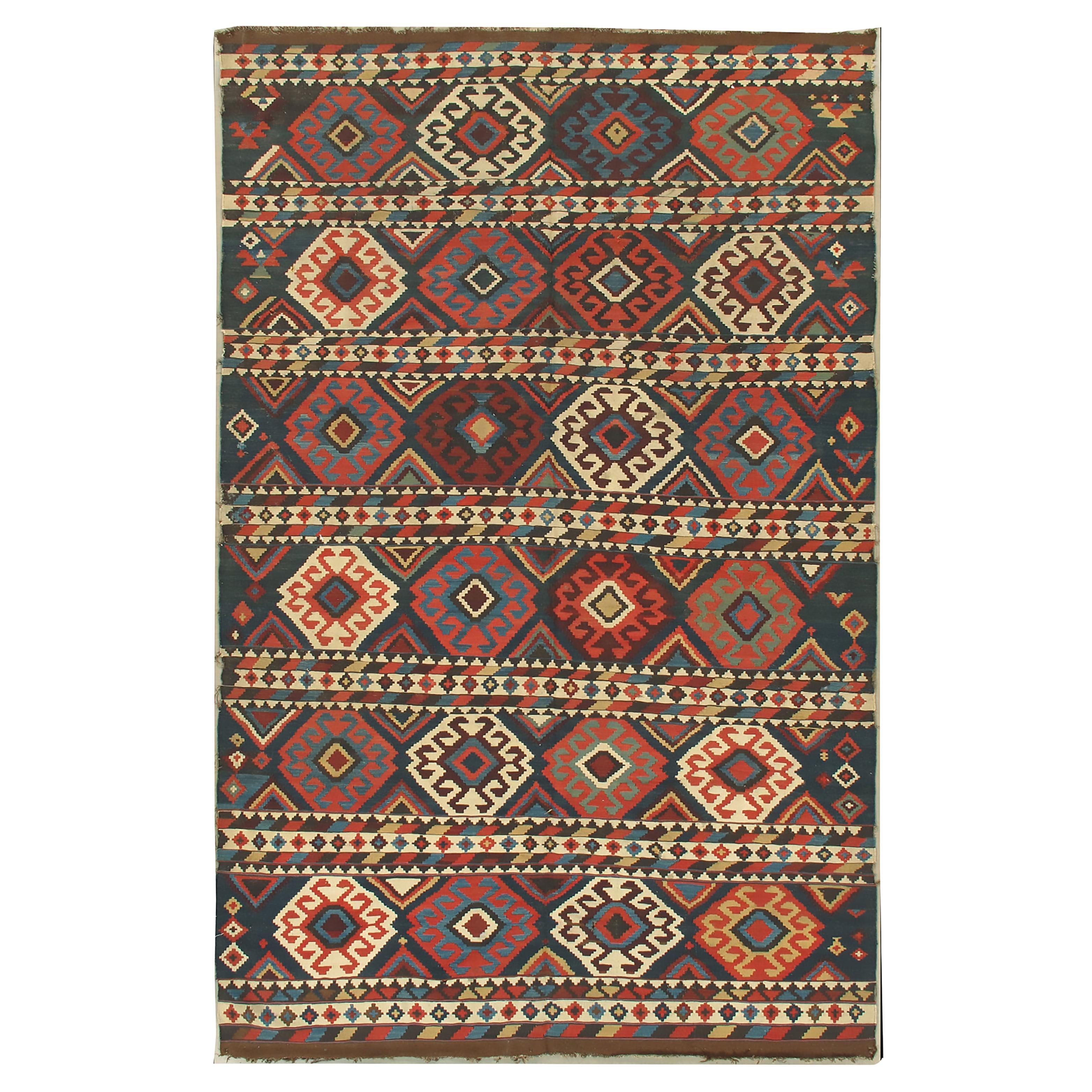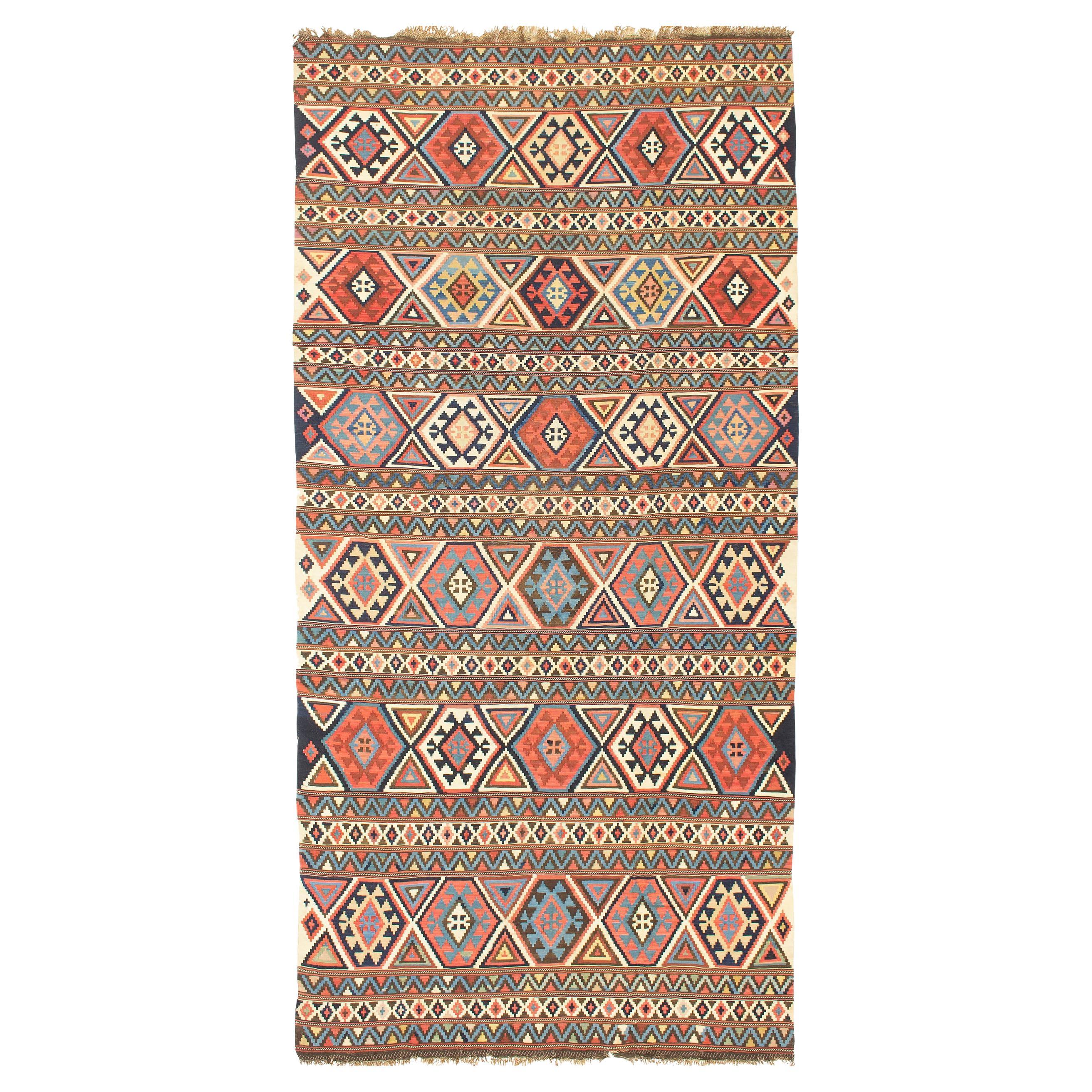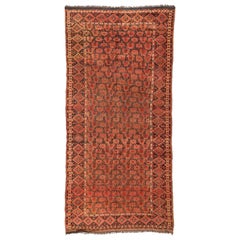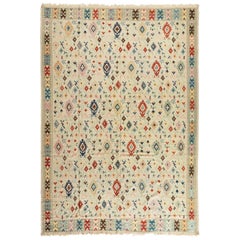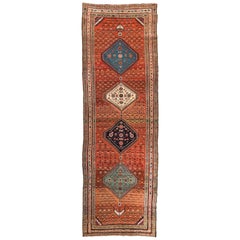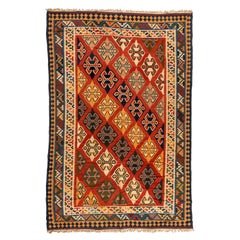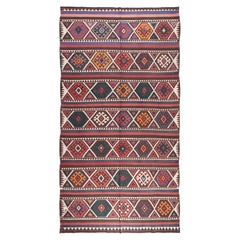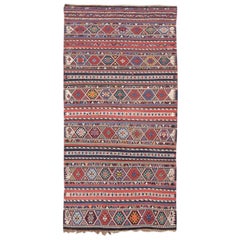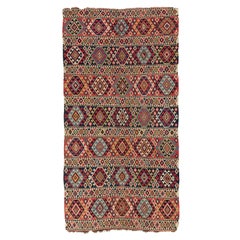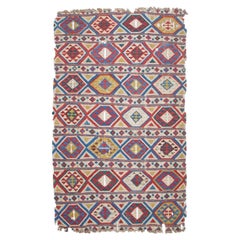Items Similar to Antique Shirvan Caucasian Kilim Flat Weave Rug, circa 1880s-1900s
Want more images or videos?
Request additional images or videos from the seller
1 of 5
Antique Shirvan Caucasian Kilim Flat Weave Rug, circa 1880s-1900s
$2,240
$2,80020% Off
£1,697.29
£2,121.6120% Off
€1,944.10
€2,430.1320% Off
CA$3,172.71
CA$3,965.8820% Off
A$3,462.16
A$4,327.7020% Off
CHF 1,815.96
CHF 2,269.9520% Off
MX$42,049.08
MX$52,561.3620% Off
NOK 22,682.35
NOK 28,352.9420% Off
SEK 21,435.96
SEK 26,794.9520% Off
DKK 14,510.06
DKK 18,137.5820% Off
About the Item
Kilim, a word of Turkish origin, denotes a pileless textile of many uses produced by one of several flat-weaving techniques that have a common or closely related heritage and are practiced in the geographical area that includes parts of Turkey (Anatolia and Thrace), North Africa, the Balkans, the Caucasus, Iran, Afghanistan, Pakistan, Central Asia and China.
Kilims are generally woven with the slitweave technique. The slit refers to the gap left between two blocks of color. It is created by returning the weft around the last warp in a color area, and the weft of the adjacent color is later returned around the adjacent warp.
The major difference between a kilim area rug and a carpet or a pile rug is that whereas the design visible on a pile rug is made by individual short strands of different color being knotted onto the warps and held together by pressing the wefts tightly, kilim designs are made by interweaving the variously colored wefts and warps, thus creating what is known as a flat-weave.
Weavers pack the weft tightly to completely cover the warp and often favor diagonal patterns so as to avoid weakening the structure of the rug with vertical slits. It produces bold, sharp patterns that weavers enjoy creating with more freedom allowed than a plainweave. This is also why kilims are so closely associated with geometrical designs even though there are kilims with floral designs as well.
This lovely antique Shirvan Caucasian Kilim carpet measures 4 x 10.8 ft and is from circa 1880s-1900s.
- Dimensions:Width: 48 in (121.92 cm)Length: 128 in (325.12 cm)
- Style:Kilim (In the Style Of)
- Materials and Techniques:Wool,Hand-Woven
- Place of Origin:
- Period:
- Date of Manufacture:1880-1900
- Condition:Wear consistent with age and use. Minor edging needed on the right side in 3 spots. Kindly reference images.
- Seller Location:New York, NY
- Reference Number:Seller: R10421stDibs: LU5138117852771
About the Seller
5.0
Vetted Professional Seller
Every seller passes strict standards for authenticity and reliability
Established in 1972
1stDibs seller since 2019
105 sales on 1stDibs
Typical response time: <1 hour
- ShippingRetrieving quote...Shipping from: Secaucus, NJ
- Return Policy
Authenticity Guarantee
In the unlikely event there’s an issue with an item’s authenticity, contact us within 1 year for a full refund. DetailsMoney-Back Guarantee
If your item is not as described, is damaged in transit, or does not arrive, contact us within 7 days for a full refund. Details24-Hour Cancellation
You have a 24-hour grace period in which to reconsider your purchase, with no questions asked.Vetted Professional Sellers
Our world-class sellers must adhere to strict standards for service and quality, maintaining the integrity of our listings.Price-Match Guarantee
If you find that a seller listed the same item for a lower price elsewhere, we’ll match it.Trusted Global Delivery
Our best-in-class carrier network provides specialized shipping options worldwide, including custom delivery.More From This Seller
View AllAntique Red Caucasian Bashir Rug, circa 1880s 1900s
Located in New York, NY
This lovely antique Caucasian Bashir carpet from Afghanistan, circa 1880-1900, measures: 5.8 x 12 ft. It is in pristine condition.
Provenance:
Christie's Auction House, New York,...
Category
Antique Late 19th Century Afghan Tribal Persian Rugs
Materials
Wool
Vintage Ivory Multicolored Diamond Eastern European Kilim Flat Weave Rug, 1960s
Located in New York, NY
Kilim, a word of Turkish origin, denotes a pileless textile of many uses produced by one of several flat-weaving techniques that have a common or closely related heritage and are practiced in the geographical area that includes parts of Turkey (Anatolia and Thrace), North Africa, the Balkans, the Caucasus, Iran, Afghanistan, Pakistan, Central Asia and China.
Kilims are generally woven with the slitweave technique. The slit refers to the gap left between two blocks of color. It is created by returning the weft around the last warp in a color area, and the weft of the adjacent color is later returned around the adjacent warp.
The major difference between a kilim area rug and a carpet or a pile rug is that whereas the design visible on a pile rug is made by individual short strands of different color being knotted onto the warps and held together by pressing the wefts tightly, kilim designs are made by interweaving the variously colored wefts and warps, thus creating what is known as a flat-weave.
Weavers pack the weft tightly to completely cover the warp and often favor diagonal patterns so as to avoid weakening the structure of the rug with vertical slits. It produces bold, sharp patterns that weavers enjoy creating with more freedom allowed than a plainweave. This is also why kilims are so closely associated with geometrical designs even though there are kilims with floral designs as well.
This lovely antique Eastern European Kilim...
Category
Vintage 1960s European Kilim Caucasian Rugs
Materials
Wool
Antique Caucasian Geometric Rust and Blue Karabagh Runner Rug circa 1900-1910s
Located in New York, NY
The old province of Karabagh lies to the north of the Aras River, just north of the present Iranian border. Karabagh rugs are known for their exceptional quality and highly desired d...
Category
Antique Early 1900s Caucasian Tribal Caucasian Rugs
Materials
Wool
Antique Red Caucasian Kilim Geometric Rug, circa 1940s 6.10 x 10.5 ft.
Located in New York, NY
Kilim, a word of Turkish origin, denotes a pileless textile of many uses produced by one of several flat-weaving techniques that have a common or closely related heritage and are pra...
Category
Vintage 1940s Caucasian Kilim Caucasian Rugs
Materials
Wool
$2,240 Sale Price
20% Off
Vintage Red White Blue Tribal Turkish Kilim Area Rug, circa 1960s
Located in New York, NY
Kilim, a word of Turkish origin, denotes a pileless textile of many uses produced by one of several flat-weaving techniques that have a common or closely related heritage and are pra...
Category
Vintage 1960s Persian Kilim Caucasian Rugs
Materials
Wool
Antique Vintage Rose Brown Blue Tribal Persian Afshar Area Rug, circa 1900-1910
Located in New York, NY
This is a lovely antique Persian Afshar rug hand knotted in Iran in the 1900s-1910s and measures 4.2 x 6.5 ft.
Category
Antique Early 1900s Persian Tribal Persian Rugs
Materials
Wool
You May Also Like
Vintage Shirvan Kilim Rug, Handwoven Caucasian Old Carpet
Located in Tokyo, JP
This is an old Shirvan Kilim from the Caucasus region with a rare and beautiful color composition.
Of the four countries that make up the Caucasus, Azerbaijan produces the most kilims, and the land has a long history of weaving. The nomadic tribes wove kilims and carpets as well as a wide range of storage bags and sacks, such as saffrash, khurgin and chula, and donkey and horse trappings. Smaller bags...
Category
Late 20th Century Caucasian Kilim Caucasian Rugs
Materials
Natural Fiber, Wool
Antique Caucasian Shirvan Kilim, Late 19th Century
Located in San Francisco, CA
Antique Caucasian Shirvan Kilim Rug, Late 19th Century
This Caucasian Shirvan kilim combines a fine weave with diverse colors incorporating no fewer than three reds and blues each, ...
Category
Antique Late 19th Century Caucasian Caucasian Rugs
Materials
Wool
5.2x10 Ft Antique Caucasian Shirvan Kilim Rug, Ca 1870, 100% Wool & Natural Dyes
Located in Spring Valley, NY
A rare antique Caucasian Shirvan Kilim (flat-woven rug) with wonderfully saturated natural dyes and beautiful geometric design. Very good condition. Sturdy and as clean as a brand ne...
Category
Antique 19th Century Caucasian Kilim Caucasian Rugs
Materials
Wool
$3,125 Sale Price
50% Off
Free Shipping
Antique Caucasian Shirvan Kilim, Late 19th Century
Located in San Francisco, CA
Antique Shirvan Kilim Rug, Late 19th Century
Additional Information:
Dimensions: 7'9" L x 4'7" W
Origin: Caucasus
Period: Late 19th Century
Rug ID: 15220
Category
Antique Late 19th Century Caucasian Caucasian Rugs
Materials
Wool
Antique Caucasian Shirvan Kilim Rug 5'5 x 9'10
Located in New York, NY
Antique Caucasian Shirvan Kilim Rug 5'5 x 9'10. This is a Shirvan Kilim long rug with a pattern of wide navy horizontal rows of stepped hexagons enclosing smaller, similar hooked devices. Instead of wide and somewhat narrower bands alternating, the latter have shrunk to thinner ivory lines with stepped crosses as ornaments. Terra cotta, ivory, medium blue, yellow-tan and brown-lack are among the salient tones of this slit tapestry carpet with a generally more restrained palette. At the ends of the broad sections are amusing geometric fillers. The general tonality extends to the dark grey-brown barber pole warps. In their country of origin, these kilims had multiple functions: floor coverings, room dividers, wall decorations, cart covers, indeed any place where a durable, colorful larger scale textile...
Category
Antique 19th Century Caucasian Caucasian Rugs
Materials
Wool
Antique Late 19th Century Shirvan Kilim
Located in Closter, NJ
The Shirvan region is one of the major weaving areas of the eastern Caucasus that lies on the coast of the Caspian Sea. There are many towns in this region which have become associa...
Category
Antique Late 19th Century Armenian Tribal Caucasian Rugs
Materials
Wool
